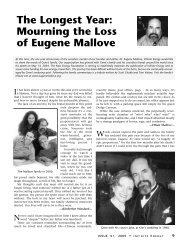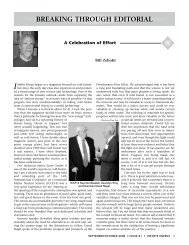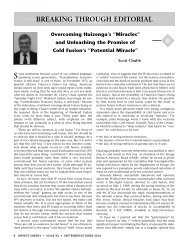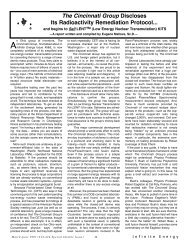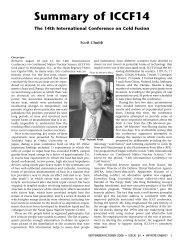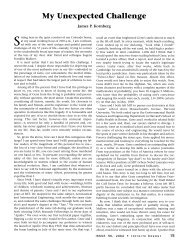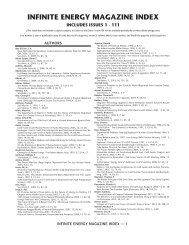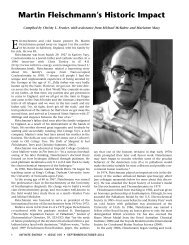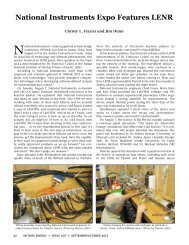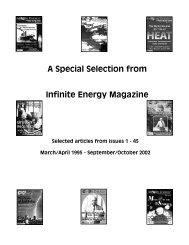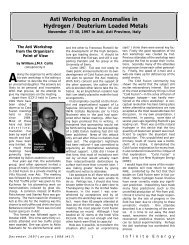MIT and Cold Fusion: A Special Report - Infinite Energy Magazine
MIT and Cold Fusion: A Special Report - Infinite Energy Magazine
MIT and Cold Fusion: A Special Report - Infinite Energy Magazine
Create successful ePaper yourself
Turn your PDF publications into a flip-book with our unique Google optimized e-Paper software.
Fall 1991 (NASW’s)* Newsletter (“SW”)<br />
SCIENCE WRITER QUITS <strong>MIT</strong> NEWS OFFICE,<br />
CITES COLD-FUSION DISPUTE<br />
by Lee Edson (Reprinted with permission from NASW).<br />
Photo by E. Mallove<br />
(Freelance writer living in Stamford, CT)<br />
“I am convinced at greater than 99% confidence<br />
level that cold fusion is real—both the<br />
nuclear emanations that have been reported<br />
<strong>and</strong> the excess enthalpy that seems to emerge<br />
from various experiments.” Thus did Eugene<br />
Mallove, chief science writer of the <strong>MIT</strong> News<br />
Office, write to <strong>MIT</strong> President Charles Vest in<br />
April 1991. After detailing new, <strong>and</strong> as he put<br />
it, astounding findings in Russia <strong>and</strong> India, he<br />
decried the lack of experimental work on cold<br />
fusion at <strong>MIT</strong> “after the initial but intense<br />
period of experimental assessment in the<br />
spring of 1989.”<br />
Mallove based his expertise in large part on his research for Fire<br />
from Ice, an optimistic book on cold fusion published in July by John<br />
Wiley & Sons. He also holds a B.S. <strong>and</strong> M.S. in astronautical engineering<br />
from <strong>MIT</strong>, a Sc.D. in environmental health sciences from Harvard,<br />
<strong>and</strong> has authored several other scientific books.<br />
Urging the <strong>MIT</strong> president to set up a panel to investigate the status<br />
of research on cold fusion, Mallove went on to say, “I do not feel<br />
that MlT's interests are best served any longer by unwarranted<br />
ignoring of the mounting experimental evidence for cold fusion. It<br />
seems to me essential that members of the <strong>MIT</strong> community reassess<br />
experimental findings that are coming from both foreign <strong>and</strong><br />
domestic laboratories. To do any less would be an abdication of scientific<br />
responsibility, not to mention a longer range injury to the<br />
reputation of <strong>MIT</strong>. . .”<br />
By June, Mallove had not heard from <strong>MIT</strong> <strong>and</strong> was convinced that<br />
the scientific community had closed its mind to cold fusion as a real<br />
phenomenon, even if not promising as a source of endless cheap energy.<br />
Frustrated <strong>and</strong> feeling uncomfortable about continuing his role as<br />
a spokesman for <strong>MIT</strong>, NASWer Mallove quit his job in the News<br />
Office, announcing his resignation at a public meeting, <strong>and</strong> submitted<br />
a 17-page “J’Accuse” letter to his alma mater. The litany of charges<br />
exp<strong>and</strong>ed on his earlier note to the president. He accused the university<br />
of publishing fudged experimental findings to support MlT’s early<br />
condemnation of the work of Pons <strong>and</strong> Fleischmann—a condemnation<br />
he charged that helped propel the nation's negative tone toward the<br />
Utah scientists.<br />
Mallove went on to blast <strong>MIT</strong> Professor Ronald Parker, head of<br />
the Plasma <strong>Fusion</strong> Center, for “using” him <strong>and</strong> the press of– fice in<br />
publishing a false press release. In that release Parker had denied<br />
that he had ever called Pons <strong>and</strong> Fleischmann frauds as reported by<br />
Nick Tate in the Boston Herald. Tate later produced transcripts that<br />
showed Parker had indeed used the expression “fraud” on several<br />
occasions, <strong>and</strong> in a classic riposte Parker said that he didn’t mean it<br />
in connection with the controversial cold fusion findings.<br />
Mallove also charged that the university was seeking to censor<br />
his writings by killing a 9,000-word article that he had written for<br />
the <strong>MIT</strong> magazine, Technology Review, explaining his views on cold<br />
fusion. He claimed the article had been accepted after revision but<br />
was later turned down because of the negative comments of<br />
reviewers, especially by an <strong>MIT</strong> physicist who was violently anticold<br />
fusion. (In a subsequent telephone interview Jonathan Schlefer,<br />
the former managing editor of Technology Review, who told me<br />
he was responsible for rejecting the article, firmly denied Mallove’s<br />
allegations, saying that his article was too one-sided <strong>and</strong> not up to<br />
snuff.)[Ed. Note: This reconstruction by Schlefer is utterly false—<br />
EFM]. Nevertheless, Mallove was paid the full price of $1,000 for<br />
the article.<br />
The core of the scientific misconduct alleged by Mallove has to<br />
do with calorimetry experiments performed by Professor Parker<br />
<strong>and</strong> his group. In one calorimetry experiment a Pons-Fleischmann<br />
electrochemical cell was filled with heavy water <strong>and</strong> a control cell<br />
with ordinary water. The power curves generated were published<br />
in the Journal of <strong>Fusion</strong> <strong>Energy</strong> <strong>and</strong> came out looking essentially the<br />
same, apparently indicating that the heavy-water cell had not produced<br />
excess heat as might have been expected if a fusion process<br />
were going on. Mallove says that the heavy-water curve was shifted<br />
by the experimenters to make it look the same as the ordinary<br />
water curve but that actually the heavy-water cell experiment did<br />
show excess heat. Parker’s explanation is that the shift was made<br />
in accordance with conventional data treatment.<br />
All this came at time when <strong>MIT</strong> was still reeling from the Baltimore-Imanishi-Margot<br />
O'Toole furor. Perhaps that is why<br />
Mallove's resignation drew only mixed attention from the media.<br />
The Boston Herald, UPl, the Chronicle of Higher Education, <strong>and</strong> the<br />
Christian Science Monitor thought it newsworthy, but The New York<br />
Times, Science magazine, <strong>and</strong> Nature, which would normally have<br />
covered or at least noted such a dramatic form of professional selfimmolation<br />
in academia, were notably silent. Interestingly the Wall<br />
Street Journal, which in July reported a series of new cold fusion<br />
findings (or “sightings of the dead” as the physicists regard them),<br />
failed to mention Mallove's whistle-blowing departure from <strong>MIT</strong>.<br />
The <strong>MIT</strong> administration also did not respond, although Professor<br />
Parker said he thought the affair ridiculous <strong>and</strong> dismissed the<br />
alleged new evidence of cold fusion as no evidence at all.<br />
Mallove then accepted an invitation from National Public Radio<br />
to air the controversy over WBUR in Boston. The broadcast of 9<br />
August 1991 led off with: “A crisis of confidence in Boston's leading<br />
research institution . . .<strong>MIT</strong> scientists are now being charged<br />
with manipulating the media <strong>and</strong> altering data in an attempt to<br />
shoot down the work of the Utah scientists.”<br />
Then Mallove's voice cut in: “What went on behind closed doors at<br />
my alma mater is so upsetting that I will not rest until the whole matter<br />
is given thorough airing. We have a major big science program, hot<br />
fusion, which is literally trying to squash cold fusion.”<br />
In late August, Mallove pressed Parker <strong>and</strong> his group for their<br />
lab notebooks to allow for an independent check of the calorimetry<br />
work in 1989. So far, he says, only an item or two has turned up.<br />
Parker insists that it isn’t worth the effort to have an assistant generate<br />
all the lab data involved. While Mallove interprets this as bad<br />
faith, the prevailing view at <strong>MIT</strong> is that rather than fraud the scientists<br />
involved may have conducted poor science that they would<br />
not like to expose.<br />
Mallove has now escalated the furor once again by dispatching a<br />
registered letter to Mary Rowe, assistant to the president of <strong>MIT</strong>,<br />
requesting a formal inquiry into the misconduct charges. This time<br />
Nature did report the incident as a cold-fusion tempest at <strong>MIT</strong>. Much<br />
of the betting is that a formal inquiry is unlikely to take place, mainly<br />
because it would be hard to prove malicious intent, <strong>and</strong> even if the<br />
data had been improperly h<strong>and</strong>led at a time of high tension at <strong>MIT</strong>,<br />
it would mark only a minor footnote to the now largely discredited<br />
work of Pons <strong>and</strong> Fleischmann.<br />
Is there life beyond the <strong>MIT</strong> News Office for Mallove? Apparently<br />
yes. At 44 he intends to retain his post as a lecturer in science<br />
journalism in the humanities department at <strong>MIT</strong> <strong>and</strong> he enjoys the<br />
thought of no longer daily commuting 60 miles to Cambridge from<br />
his home in Bow, New Hampshire. He has a dozen book proposals<br />
making the rounds of publishing houses <strong>and</strong> if none of them works<br />
out, he could return, he says, to an early love—the entrepreneurial<br />
life. In the 1980s he produced astronomical materials such as sky<br />
maps for museums <strong>and</strong> consulted with aerospace manufacturers<br />
like Hughes on the potential of innovative space propulsion systems.<br />
At the moment he has no special plans for cold fusion except to<br />
write a sequel to his book—assuming, of course, that there is also a<br />
sequel to cold fusion.<br />
✍✍✍<br />
31 <strong>Infinite</strong> <strong>Energy</strong> • ISSUE 24, 1999 • <strong>MIT</strong> <strong>Special</strong> <strong>Report</strong>



